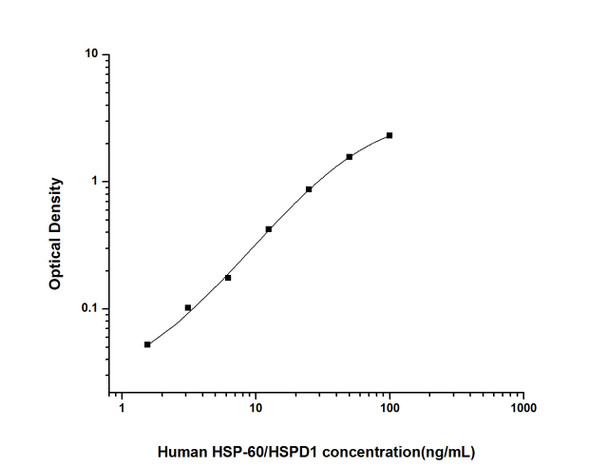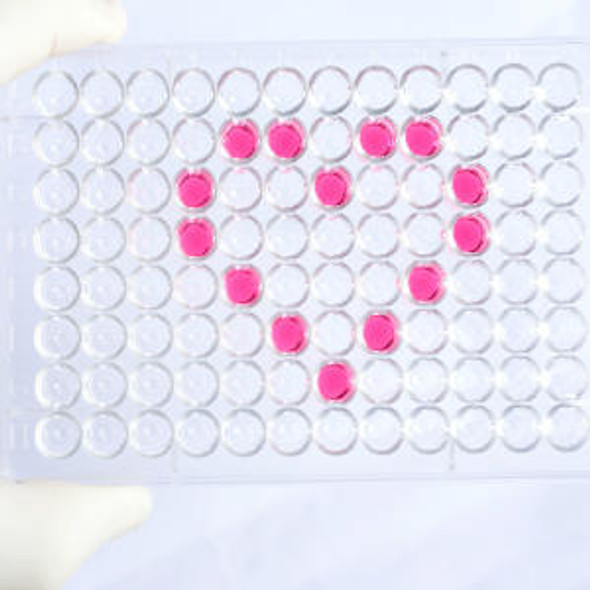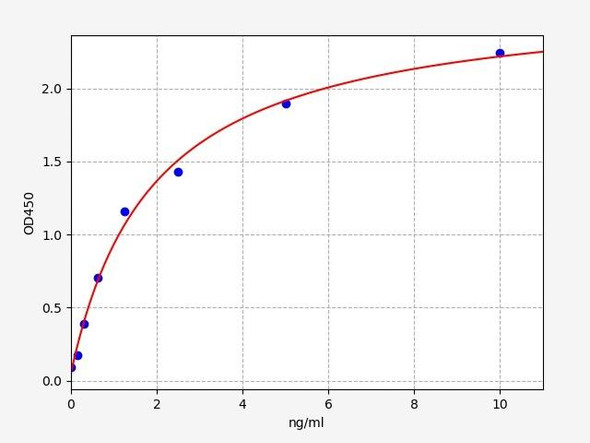Human Immunology ELISA Kits 2
Human HSP-60/HSPD1 (Heat Shock Protein 60) ELISA Kit (HUES02814)
- SKU:
- HUES02814
- Product Type:
- ELISA Kit
- Size:
- 96 Assays
- Uniprot:
- P10809
- Sensitivity:
- 0.94ng/mL
- Range:
- 1.56-100ng/mL
- ELISA Type:
- Sandwich
- Synonyms:
- HSPD1, CPN60, GROEL, HLD4, HSP-60, HSP60, HSP65, HuCHA60, SPG13
- Reactivity:
- Human
- Sample Type:
- Serum, plasma and other biological fluids
- Research Area:
- Immunology
Description
| Assay type: | Sandwich |
| Format: | 96T |
| Assay time: | 4.5h |
| Reactivity: | Human |
| Detection Method: | Colormetric |
| Detection Range: | 1.56-100 ng/mL |
| Sensitivity: | 0.94 ng/mL |
| Sample Volume Required Per Well: | 100µL |
| Sample Type: | Serum, plasma and other biological fluids |
| Specificity: | This kit recognizes Human HSP-60/HSPD1 in samples. No significant cross-reactivity or interference between Human HSP-60/HSPD1 and analogues was observed. |
This ELISA kit uses Sandwich-ELISA as the method. The micro ELISA plate provided in this kit has been pre-coated with an antibody specific to Human HSP-60/HSPD1. Standards or samples are added to the appropriate micro ELISA plate wells and combined with the specific antibody. Then a biotinylated detection antibody specific for Human HSP-60/HSPD1 and Avidin-Horseradish Peroxidase (HRP) conjugate are added to each micro plate well successively and incubated. Free components are washed away. The substrate solution is added to each well. Only those wells that contain Human HSP-60/HSPD1, biotinylated detection antibody and Avidin-HRP conjugate will appear blue in color. The enzyme-substrate reaction is terminated by adding Stop Solution and the color turns yellow. The optical density (OD) is measured spectrophotometrically at a wavelength of 450 nm ± 2 nm. The OD value is proportional to the concentration of Human HSP-60/HSPD1. The concentration of Human HSP-60/HSPD1 in samples can be calculated by comparing the OD of the samples to the standard curve.
| UniProt Protein Function: | HSP60: Implicated in mitochondrial protein import and macromolecular assembly. May facilitate the correct folding of imported proteins. May also prevent misfolding and promote the refolding and proper assembly of unfolded polypeptides generated under stress conditions in the mitochondrial matrix. Interacts with HRAS. Interacts with HBV protein X and HTLV-1 protein p40tax. Belongs to the chaperonin (HSP60) family. |
| UniProt Protein Details: | Protein type:Chaperone; Mitochondrial Chromosomal Location of Human Ortholog: 2q33. 1 Cellular Component: extracellular space; cell surface; protein complex; mitochondrion; early endosome; coated pit; cytosol; secretory granule; membrane; mitochondrial matrix; cytoplasm; mitochondrial inner membrane; plasma membrane; lipopolysaccharide receptor complex; cyclin-dependent protein kinase activating kinase holoenzyme complex Molecular Function:protein binding; p53 binding; lipopolysaccharide binding; ubiquitin protein ligase binding; chaperone binding; ATPase activity; double-stranded RNA binding; unfolded protein binding; DNA replication origin binding; single-stranded DNA binding; ATP binding Biological Process: B cell proliferation; caspase activation; B cell activation; T cell activation; protein stabilization; viral reproduction; positive regulation of apoptosis; positive regulation of interleukin-12 production; protein maturation; isotype switching to IgG isotypes; positive regulation of interleukin-6 production; B cell cytokine production; positive regulation of interleukin-10 production; response to unfolded protein; MyD88-dependent toll-like receptor signaling pathway; positive regulation of interferon-gamma production; 'de novo' protein folding; protein refolding; positive regulation of T cell activation; positive regulation of T cell mediated immune response to tumor cell; chaperone-mediated protein complex assembly; positive regulation of interferon-alpha production; negative regulation of apoptosis; positive regulation of macrophage activation Disease: Spastic Paraplegia 13, Autosomal Dominant; Leukodystrophy, Hypomyelinating, 4 |
| NCBI Summary: | This gene encodes a member of the chaperonin family. The encoded mitochondrial protein may function as a signaling molecule in the innate immune system. This protein is essential for the folding and assembly of newly imported proteins in the mitochondria. This gene is adjacent to a related family member and the region between the 2 genes functions as a bidirectional promoter. Several pseudogenes have been associated with this gene. Two transcript variants encoding the same protein have been identified for this gene. Mutations associated with this gene cause autosomal recessive spastic paraplegia 13. [provided by RefSeq, Jun 2010] |
| UniProt Code: | P10809 |
| NCBI GenInfo Identifier: | 129379 |
| NCBI Gene ID: | 3329 |
| NCBI Accession: | P10809. 2 |
| UniProt Secondary Accession: | P10809,Q38L19, Q9UCR6, B2R5M6, B7Z712, |
| UniProt Related Accession: | P10809 |
| Molecular Weight: | 17,100 Da |
| NCBI Full Name: | 60 kDa heat shock protein, mitochondrial |
| NCBI Synonym Full Names: | heat shock 60kDa protein 1 (chaperonin) |
| NCBI Official Symbol: | HSPD1 |
| NCBI Official Synonym Symbols: | HLD4; CPN60; GROEL; HSP60; HSP65; SPG13; HSP-60; HuCHA60 |
| NCBI Protein Information: | 60 kDa heat shock protein, mitochondrial; chaperonin 60; 60 kDa chaperonin; heat shock protein 65; P60 lymphocyte protein; mitochondrial matrix protein P1; short heat shock protein 60 Hsp60s1 |
| UniProt Protein Name: | 60 kDa heat shock protein, mitochondrial |
| UniProt Synonym Protein Names: | 60 kDa chaperonin; Chaperonin 60; CPN60; Heat shock protein 60; HSP-60; Hsp60; HuCHA60; Mitochondrial matrix protein P1; P60 lymphocyte protein |
| Protein Family: | 60 kDa heat shock protein |
| UniProt Gene Name: | HSPD1 |
| UniProt Entry Name: | CH60_HUMAN |
As the OD values of the standard curve may vary according to the conditions of the actual assay performance (e. g. operator, pipetting technique, washing technique or temperature effects), the operator should establish a standard curve for each test. Typical standard curve and data is provided below for reference only.
| Concentration (ng/mL) | O.D | Average | Corrected |
| 100 | 2.374 2.39 | 2.382 | 2.308 |
| 50 | 1.635 1.639 | 1.637 | 1.563 |
| 25 | 0.955 0.931 | 0.943 | 0.869 |
| 12.5 | 0.481 0.515 | 0.498 | 0.424 |
| 6.25 | 0.26 0.236 | 0.248 | 0.174 |
| 3.13 | 0.182 0.17 | 0.176 | 0.102 |
| 1.56 | 0.116 0.136 | 0.126 | 0.052 |
| 0 | 0.065 0.083 | 0.074 | -- |
Precision
Intra-assay Precision (Precision within an assay): 3 samples with low, mid range and high level Human HSP-60/HSPD1 were tested 20 times on one plate, respectively.
Inter-assay Precision (Precision between assays): 3 samples with low, mid range and high level Human HSP-60/HSPD1 were tested on 3 different plates, 20 replicates in each plate.
| Intra-assay Precision | Inter-assay Precision | |||||
| Sample | 1 | 2 | 3 | 1 | 2 | 3 |
| n | 20 | 20 | 20 | 20 | 20 | 20 |
| Mean (ng/mL) | 4.70 | 12.90 | 36.90 | 4.80 | 12.00 | 34.60 |
| Standard deviation | 0.30 | 0.80 | 1.80 | 0.30 | 0.70 | 1.80 |
| C V (%) | 6.38 | 6.20 | 4.88 | 6.25 | 5.83 | 5.20 |
Recovery
The recovery of Human HSP-60/HSPD1 spiked at three different levels in samples throughout the range of the assay was evaluated in various matrices.
| Sample Type | Range (%) | Average Recovery (%) |
| Serum (n=5) | 92-107 | 98 |
| EDTA plasma (n=5) | 93-107 | 100 |
| Cell culture media (n=5) | 94-111 | 101 |
Linearity
Samples were spiked with high concentrations of Human HSP-60/HSPD1 and diluted with Reference Standard & Sample Diluent to produce samples with values within the range of the assay.
| Serum (n=5) | EDTA plasma (n=5) | Cell culture media (n=5) | ||
| 1:2 | Range (%) | 96-110 | 96-114 | 87-100 |
| Average (%) | 103 | 104 | 93 | |
| 1:4 | Range (%) | 95-108 | 87-101 | 92-109 |
| Average (%) | 101 | 93 | 100 | |
| 1:8 | Range (%) | 94-109 | 82-95 | 91-105 |
| Average (%) | 101 | 87 | 97 | |
| 1:16 | Range (%) | 96-108 | 88-99 | 97-110 |
| Average (%) | 101 | 93 | 104 |
An unopened kit can be stored at 4°C for 1 month. If the kit is not used within 1 month, store the items separately according to the following conditions once the kit is received.
| Item | Specifications | Storage |
| Micro ELISA Plate(Dismountable) | 8 wells ×12 strips | -20°C, 6 months |
| Reference Standard | 2 vials | |
| Concentrated Biotinylated Detection Ab (100×) | 1 vial, 120 µL | |
| Concentrated HRP Conjugate (100×) | 1 vial, 120 µL | -20°C(shading light), 6 months |
| Reference Standard & Sample Diluent | 1 vial, 20 mL | 4°C, 6 months |
| Biotinylated Detection Ab Diluent | 1 vial, 14 mL | |
| HRP Conjugate Diluent | 1 vial, 14 mL | |
| Concentrated Wash Buffer (25×) | 1 vial, 30 mL | |
| Substrate Reagent | 1 vial, 10 mL | 4°C(shading light) |
| Stop Solution | 1 vial, 10 mL | 4°C |
| Plate Sealer | 5 pieces | |
| Product Description | 1 copy | |
| Certificate of Analysis | 1 copy |
- Set standard, test sample and control (zero) wells on the pre-coated plate and record theirpositions. It is recommended to measure each standard and sample in duplicate. Note: addall solutions to the bottom of the plate wells while avoiding contact with the well walls. Ensuresolutions do not foam when adding to the wells.
- Aliquot 100µl of standard solutions into the standard wells.
- Add 100µl of Sample / Standard dilution buffer into the control (zero) well.
- Add 100µl of properly diluted sample (serum, plasma, tissue homogenates and otherbiological fluids) into test sample wells.
- Cover the plate with the sealer provided in the kit and incubate for 90 min at 37°C.
- Aspirate the liquid from each well, do not wash. Immediately add 100µL of BiotinylatedDetection Ab working solution to each well. Cover the plate with a plate seal and gently mix. Incubate for 1 hour at 37°C.
- Aspirate or decant the solution from the plate and add 350µL of wash buffer to each welland incubate for 1-2 minutes at room temperature. Aspirate the solution from each well andclap the plate on absorbent filter paper to dry. Repeat this process 3 times. Note: a microplatewasher can be used in this step and other wash steps.
- Add 100µL of HRP Conjugate working solution to each well. Cover with a plate seal andincubate for 30 min at 37°C.
- Aspirate or decant the solution from each well. Repeat the wash process for five times asconducted in step 7.
- Add 90µL of Substrate Reagent to each well. Cover with a new plate seal and incubate forapproximately 15 min at 37°C. Protect the plate from light. Note: the reaction time can beshortened or extended according to the actual color change, but not by more than 30min.
- Add 50 µL of Stop Solution to each well. Note: Adding the stop solution should be done inthe same order as the substrate solution.
- Determine the optical density (OD value) of each well immediately with a microplate readerset at 450 nm.






